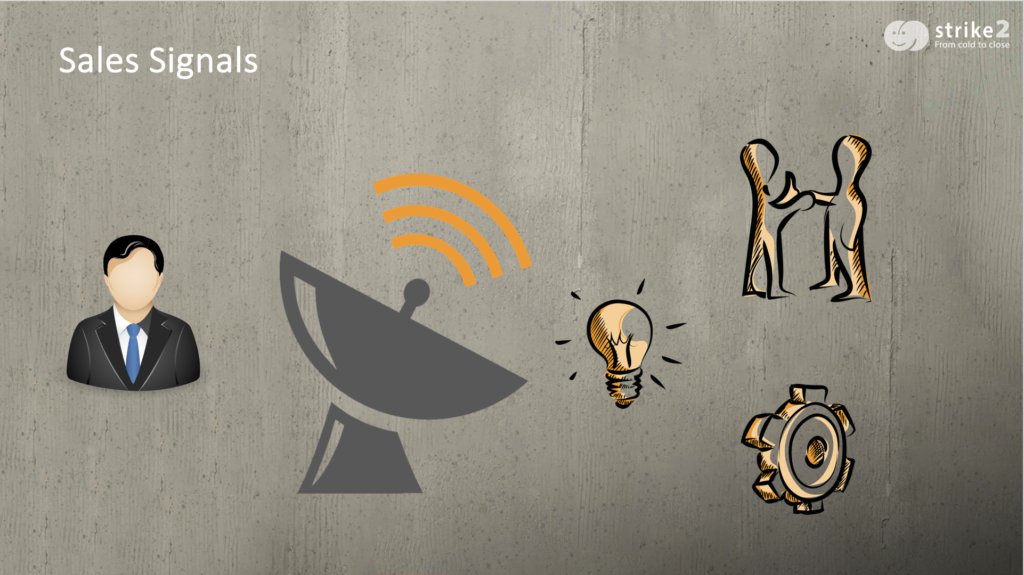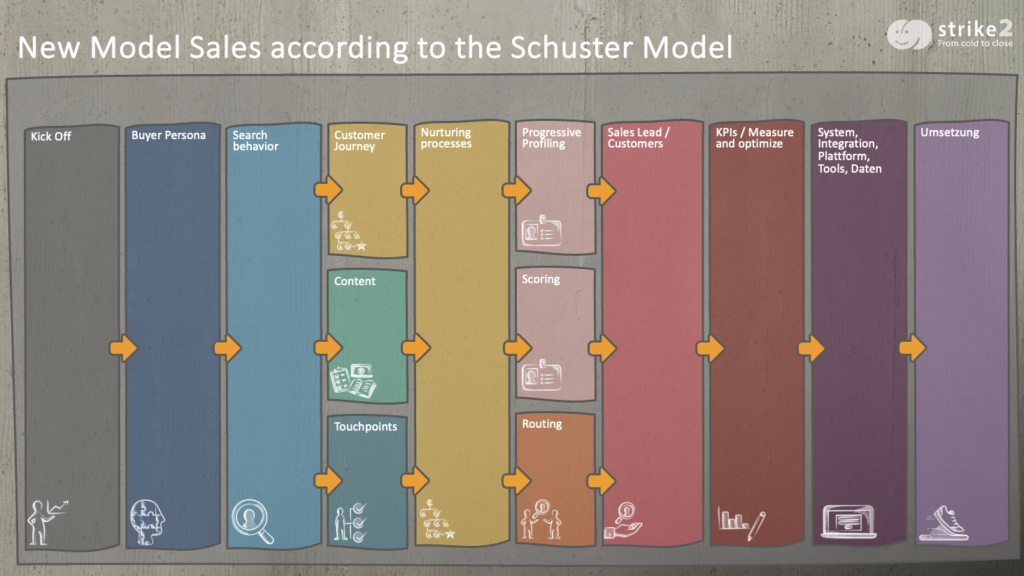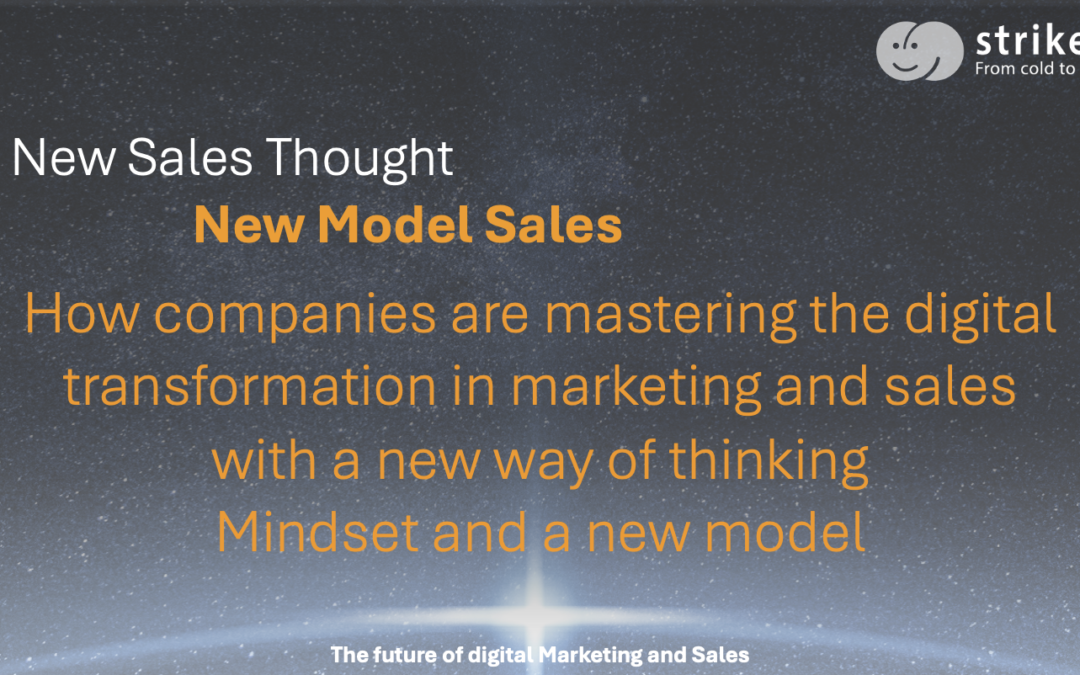How companies are mastering the digital transformation in marketing and sales with a new way of thinking and a new model
How does sales work today? How can we organise modern sales in such a way that we master the challenges of our time that companies have to face in order to survive and grow? And how do we make the best and most effective use of the new opportunities offered by digitalisation? Companies need to ask themselves these questions today and find the right answers.
What thinking, what model is traditional sales based on?
In traditional sales, there were far fewer opportunities and customer contact points (touchpoints) than today. In order to acquire new customers or realise more sales with existing customers, there were predominantly only these options:
- Telephone calls
- Personal visits
- Trade fairs and events
- Letters, form letters, fax
- Adverts
- Mainly in B2C: TV and radio
These opportunities worked well for many companies for decades, even if it was a very limited framework from today’s perspective. Another important aspect for success in the past was the ‘good reputation’. Many companies have built up a good reputation over the years, some of which they still benefit from today. But is it still enough today to only utilise the set of these opportunities when customers have long since moved on?
Digital transformation
What has changed? How have (potential) customers developed? Digitalisation, the internet and new opportunities have changed how (potential) customers search, decide and buy. They have been using the possibilities of digitalisation and the internet for a long time to meet their needs and buy or book the corresponding products and services. They search the internet and find information on social media. Even if they don’t buy directly, they do their research there and make their purchase decision based on the information they find.
Companies therefore no longer have the choice of whether to embrace the digital transformation, as their (potential) customers have long since changed their behaviour. They can no longer ignore the digital transformation. They should close the Sunday / Monday gap.
Sunday / Monday Gap
Customers who have become accustomed to new technologies and new convenience in their private lives expect the same in the business environment. Who wants to order by fax or wait until a current printed catalogue arrives when you are now used to getting extensive information on a tablet at the weekend and placing an order directly? I call this the ‘Sunday / Monday Gap’.
New Sales Thought / New Model Sales
Companies cannot survive or even grow if they react to the new behaviour of (potential) customers and to customers who have already been transformed with an outdated sales model. The new possibilities enable a new way of thinking and acting – ‘New Sales Though’ – and a new model of sales – ‘New Model Sales’.
What are the characteristics of the new sales organisation?
Empathy:
In New Model Sales, we need to know and understand our customers. We define our sales targets (new customer acquisition, repurchase, cross-selling, up-selling, etc.) and our desired customers. We build empathy and knowledge. Among other things, understanding and knowledge about:
- Customer profiles
- The pains and goals of (potential) customers
- The decision-making paths and purchasing bodies and processes (buying centre)
- The behaviour
- The expectations
- etc.
Classic buyer persona profiles are not sufficient for this empathy. The analysis of (potential) customers must go much deeper. In the Schuster Model®, we use a large portfolio of analysis areas and modules:
- Module: Profile data
- Module: Situation analysis
- Module: Pain / Gain
- Module: GAP+ Analysis
- Module: Neuro
- Module: Decision
- Module: Demand and Interest
- Module: Benefit
- Module: Customer Journey
- Module: Verification
- Module: Derivation
- Module: Search
- Module: LinkedIn Behaviour
Customer contact points / touchpoints
Prospective and existing customers use many more touchpoints today. Potential customers expect to find relevant information there and to be able to communicate with companies there. Touchpoints such as the company’s website or LinkedIn are of strategic importance in modern B2B sales. Used correctly, they offer great leverage for B2B marketing.
Data
Customer data is collected at all touchpoints, which companies can use to establish and intensify contact. This data should be recorded, analysed and converted into impulses for action. #DataDrivenSales
Sales signals
Data contains sales signals that indicate to modern sales whether there is a sales opportunity for new customer acquisition or existing customer sales. The sales signals provide impetus for personal contact or automated processes.

It is important to receive the sales signals, interpret them and convert them into an action. The action can be a personal contact or an automated process.
Content
Content is the fuel for almost all processes in modern marketing and sales. However, it only fulfils this function if it is relevant, helpful or entertaining. The basis for this, in turn, is empathy for prospects and customers. Only those who know their customers can create relevant content for them. Generative AI can help here, but it cannot replace empathy.
Automation
Automated processes support sales in various marketing and sales processes:
- Development of prospective customers to sales maturity (lead nurturing)
- Reactivation of existing customers (repeat, cross-selling or up-selling nurturing)
- Prevention of customer churn (churn management)
- Support for B, C and D customers
- Trade fair and event management
- Funnel management
- Order processing
- Service processes
- and many more
Advantages New Sales Thought / New Model Sales
Dealing with the digital transformation in marketing and sales is no longer an option for companies, but a prerequisite for mastering the current challenges, their survival and growth in the future. The best time to deal with this would have been a few years ago, the second best time is now.Companies need a targeted strategy in order to exploit the opportunities and potential of digitalisation to achieve their corporate and sales goals. In the strategy, they also define how they combine digital options with traditional measures and opportunities.
Canvas model for the development of a digital strategy for modern marketing and sales
In this way, they cement the basis for the future viability and growth of their company and benefit from many advantages.

Efficiency
If marketing and sales take care of the most promising prospects and customers in the best possible way, this increases efficiency enormously. The recorded data and sales signals support the optimised approach. The automated processes minimise manual effort.
ScalingAutomated processes and findings can be transferred to other business units, branches and countries. This reduces costs and accelerates successful conceptualisation and implementation.
Options for decision-making and action
The data that can be collected and analysed thanks to the possibilities of digitalisation provides management and implementation levels with valuable information and transparency for decisions and activities.
Probability of closing a deal / sales success
However, the most significant benefit is probably the increase in the probability of closing deals and sales success.
Use the possibilities of digitalisation in marketing and sales now.


